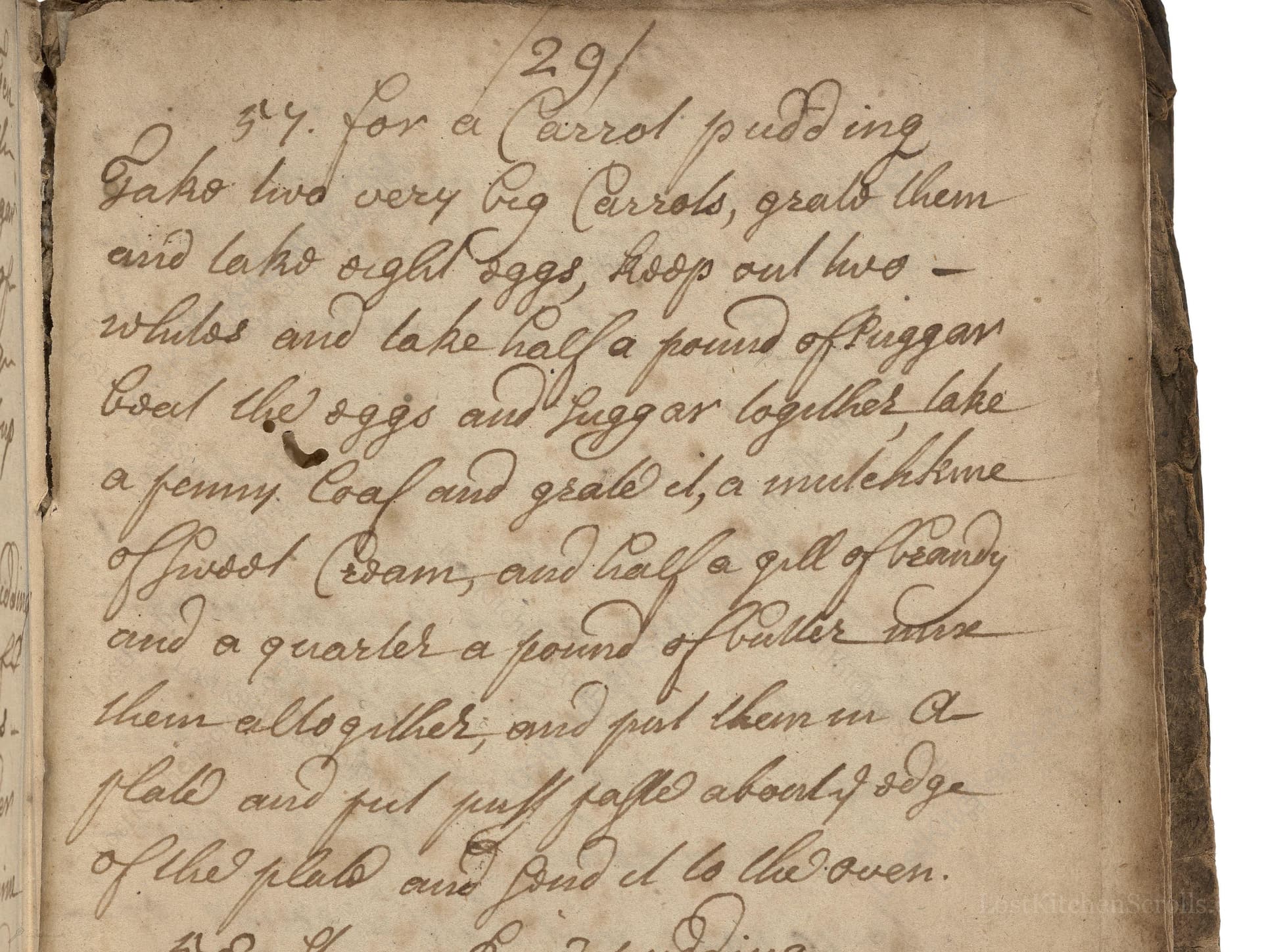For A Carrot Pudding
From the treasured pages of Receipts for cookery and pastry work
Written by Mrs. Johnston

For A Carrot Pudding
"Take two very big Carrots, grate them and take eight Eggs, keep out two whites and take half a pound of suggar. Beat the eggs and suggar together, take a penny Loaf and grate it, a mutchkine of sweet Cream, and half a gill of brandy and a quarter a pound of Butter mix them altogether, and put them in a plate and put puff paste about ye edge of the plate and send it to the oven."
Note on the Original Text
The recipe employs period spelling and phrasing, such as 'suggar,' 'mutchkine,' and 'ye edge,' common to early 1700s Scots-English manuscripts. Measures like 'mutchkine' (roughly 570ml) and 'gill' (about 142ml but half of that is used here) point to historical standards. The writing style is informal and assumes familiarity with kitchen practices, leaving out oven temperatures or precise times, typical for recipes intended for experienced cooks. The instruction to 'keep out two whites' reflects frugality and the frequent 18th-century practice of refining textures by adjusting egg ratios. There are no lists of ingredients or timings, just a flowing, practical narrative.

Title
Receipts for cookery and pastry work (1700)
You can also click the book image above to peruse the original tome
Writer
Mrs. Johnston
Era
1700
Publisher
Unknown
Background
A delightful compilation of 18th-century recipes gathered by Mrs. Johnston herself, promising a charming journey through the flavors and culinary traditions of the early 1700s.
Kindly made available by
Folger Shakespeare Library
This carrot pudding recipe hails from early 18th-century Scotland, attributed to a certain Mrs. Johnston around 1700. It emerges from a time when sugar and spices were precious, and puddings—baked, boiled, or steamed—were a mainstay of impressive dinners. Carrots, sometimes called the 'poor man’s saffron,' added both sweetness and vibrant color to dishes before the widespread use of cheaper sugar and golden spices. Recipes like this reflect the domestic creativity of housewives and cooks, who made the most of seasonal produce. The use of bread as a binding filler is typical, making the pudding lighter and more delicate than its later Victorian descendants.

In Mrs. Johnston’s kitchen, this pudding would be mixed in large earthenware bowls using a substantial wooden spoon. Carrots were grated with a handheld, iron grater, and eggs beaten with a fork or an early whisk. Bread was freshly grated just before use. The mixture would be poured into a shallow, round ceramic pie dish. The decorative pastry border was hand-rolled and shaped. Baking would take place in a wood-fired oven, monitored by scent, color, and gentle prodding rather than exact temperatures.
Prep Time
20 mins
Cook Time
50 mins
Servings
10
We've done our best to adapt this historical recipe for modern kitchens, but some details may still need refinement. We warmly welcome feedback from fellow cooks and culinary historians — your insights support the entire community!
Ingredients
- 2 very large carrots (~14 oz), peeled and grated
- 8 eggs (use 6 whole, 2 yolks; reserve 2 whites for another use)
- 8 oz white sugar
- 4 oz white bread, crust removed and grated (substitute: plain white breadcrumbs or brioche)
- 1 pint (2 1/3 cups) double cream
- 1/4 cup brandy
- 4 oz unsalted butter, melted
- 1 sheet puff pastry (for edging)
Instructions
- Begin by peeling and grating two very large carrots (about 14 oz).
- In a bowl, beat 6 whole eggs and 2 yolks with 8 oz of sugar until pale and thick.
- Grate a small white bread roll (about 4 oz) to make fine crumbs, and add to the mixture.
- Stir in 1 pint (2 1/3 cups) of double cream, 1/4 cup brandy, and melt 4 oz unsalted butter, adding it to the bowl.
- Mix everything until well combined.
- Prepare a pie plate and line only the rim with ready-made puff pastry (about 1 sheet) to form a decorative edge.
- Pour in the carrot batter.
- Bake in a preheated oven at 350°F for about 45-50 minutes, or until just set and slightly golden on top.
Estimated Calories
440 per serving
Cooking Estimates
You’ll need about 20 minutes to prep the ingredients, like peeling and grating the carrots, mixing the batter, and lining the pastry. Baking takes about 50 minutes. Each serving (if cut into 10 slices) has around 440 calories.
As noted above, we have made our best effort to translate and adapt this historical recipe for modern kitchens, taking into account ingredients nowadays, cooking techniques, measurements, and so on. However, historical recipes often contain assumptions that require interpretation.
We'd love for anyone to help improve these adaptations. Community contributions are highly welcome. If you have suggestions, corrections, or cooking tips based on your experience with this recipe, please share them below.
Join the Discussion
Rate This Recipe
Dietary Preference
Main Ingredients
Culinary Technique
Occasions

Den Bockfisch In Einer Fleisch Suppen Zu Kochen
This recipe hails from a German manuscript cookbook compiled in 1696, a time whe...

Die Grieß Nudlen Zumachen
This recipe comes from a rather mysterious manuscript cookbook, penned anonymous...

Ein Boudain
This recipe comes from an anonymous German-language manuscript cookbook from 169...

Ein Gesaltzen Citroni
This recipe, dating from 1696, comes from an extensive anonymous German cookbook...
Browse our complete collection of time-honored recipes



